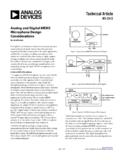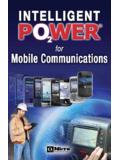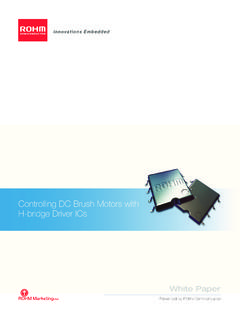Transcription of Communications System Power Supply Designs
1 LM5030,LM5041,LM5642 Communications System Power Supply DesignsLiterature Number: SNVA569 Technology EdgeCommunications System Power Supply DesignsBy L. Haachitaba Mweene & Don Ashley of National SemiconductorCommunications infrastructure equipment employs a variety of Power System components. Power factor corrected (PFC)AC/DC Power supplies with load sharing and redundancy (N+1) at the front-end feed dense, high efficiency DC/DCmodules and point-of-load converters on the back-end. A Power efficient design is required that supplies both the highervoltage analog circuits and multiple tightly regulated low-voltage supplies for the high-speed digital Communications ASIC sand recently, diverse Power Supply requirements coupled with a volatile telecommunications market have forcedequipment manufacturers to not only cut costs but to also provide more efficient and reliable Power solutions in order toremain challenging business environment has spawned new distributed voltage bus standards.
2 Such as the recent +12 VIntermediate Bus Architecture (IBA). The deployment of low-cost unregulated (open-loop) bricks to convert from the -48 Vbus to a standard +12V intermediate bus has allowed new low cost Point-of-load (POL) modules to be used. These smallform factor POL modules, now available in Single In-line Package (SIP) and surface mount device package (SMD), providea cost-effective means of providing systems loads with multiple low voltage with these new POL modules are hybrid isolated Power Supply topologies, such as the cascaded current-fed orvoltage-fed push-pull converters.
3 Semiconductor suppliers are enabling Power Supply System designers to embed low-costcompact isolated Power supplies directly onto their motherboards and line cards. New highly integrated, high-voltage(100V) Power ASICs such as the LM5041 Cascaded PWM, and LM5030 Push-Pull PWM controllers from NationalSemiconductor minimize the number of external components and printed circuit-board area required. Operating directly offthe -48V bus, the cascaded converter can produce multiple low-voltage outputs with higher overall efficiency levels at alower cost than multiple POL converters operating from a +12V intermediate bus Power Supply designer must choose between buying off-the-shelf POL and IBC modules or attempting to reduce costsand improve efficiency by embedding a semiconductor manufacturer's Power reference design .
4 The cost-versus-designcomplexity and risk trade-offs are being reviewed more seriously than ever by information System manufacturers whendeveloping new generations of cost-reduced equipment. Some will shy away from the embedded Power solution -- despitethe obvious cost and Power savings -- if the Power switches and integrated magnetic transformer introduce anuncomfortable level of PC board less complex applications requiring a single voltage Supply , the added costs and complexities of the Power transformerare minimal.
5 More complex Power Supply applications with multiple output voltages require a more complex transformerhaving multiple secondary windings. Multiple output Designs may also employ a complex regulation scheme which sensesmultiple outputs to control the feedback (VoIP), Digital Subscriber Line (DSL), and Third-generation (3G) base stations all necessitatevarying degrees of complexity in Power Supply design . We discuss factors that influence Power System design for thesethree applications Protocol (VoIP)A VoIP DC-DC converter uses a less complex single high- Power output transformer design (typ.)
6 250-500W) to buffer themain -48V distribution bus. This minimizes the cost and the capacitance of bulk capacitors required to hold up thedistribution bus voltage by narrowing the operating voltage to 43-57V from the traditional 36-72V range. Fault protectionand safety isolation are also provided to all downstream converters or other loads on the distribution bus. Using theseDC-DC converters with parallel outputs and load current-sharing, generates fault-tolerance (N+1) and heat distribution thatare conducive to cooler operation, longer life-cycles and improved converters generally require Power Supply circuit topologies that are performance-driven (highly efficient with minimalconducted line current), easy to use and cost-effective with a small footprint and low profile.
7 A number of topologies can bedesigned to meet these requirements to some degree. For example, the flyback converter with the advantage of topologicalsimplicity, is often suggested. In contrast to buck-derived converters ( , the forward converter ) the flyback does notrequire a transformer flux resetting mechanism or an output inductor. Offsetting these advantages, especially in ahigh-output voltage System such as the VOIP application, is the need for expensive capacitors to filter the large ripplecurrent at the input and output.
8 However, the ripple current problem of both flyback and forward converters can be mitigatedby interleaving two converters in anti-phase. All things being equal, the input and output ripple currents in the interleavedsystem will be significantly less than those of a single far better solution than the flyback converter for VOIP systems is the push-pull converter (Fig. 1). Fundamentally, apush-pull converter is the equivalent of two interleaved forward converters. But the push-pull converter has only onetransformer, which is self-resetting, and only one output inductor, making it only slightly more complex than a single forwardconverter.
9 The input ripple current is greatly reduced due to the interleaving effect, so smaller input inductors can be output inductor attenuates the output ripple current allowing the use of less expensive capacitors with lower ripplecurrent ratings. The flyback converter is often only suitable for up to about 150W, while the push-pull converter can performsatisfactorily in the kW Power complex topologies can also be used in the VoIP application that offers better efficiency, especially at the extremes ofthe input voltage range.
10 One example is the cascaded buck topology with a current-fed push-pull converter . (Note: theLM5041 dedicated PWM controller for this topology is now available.) This hybrid topology is an excellent choice at higherpower levels and in situations where requirements for high efficiency and performance justify the additional 1: Push-pull converter for VOIP applicationsDigital Subscriber Line (DSL)In a DSL application, a -48V to multiple output converter may be used which incorporates a more complex, lower powertransformer (50-100W) with several outputs.


















